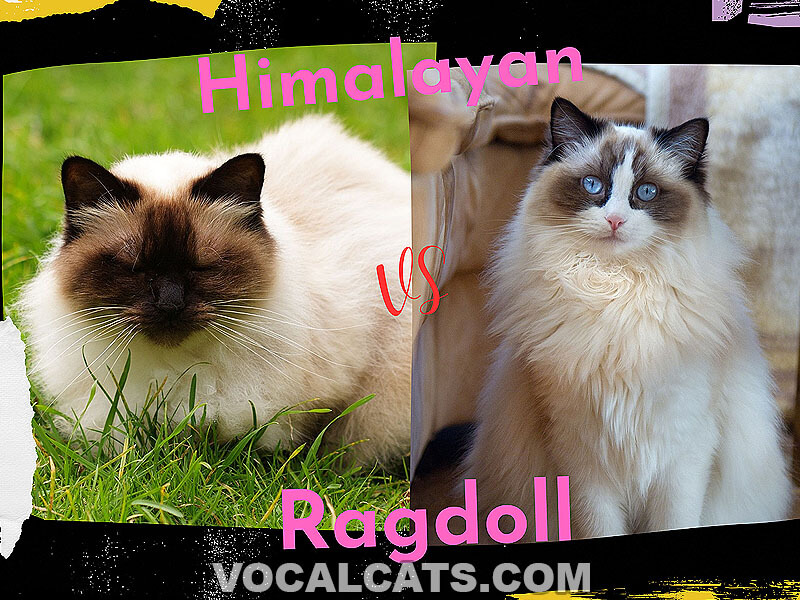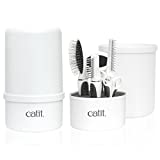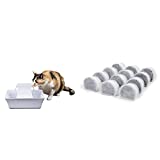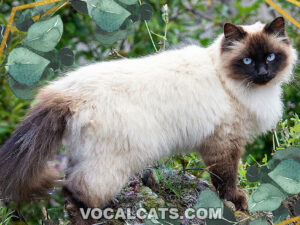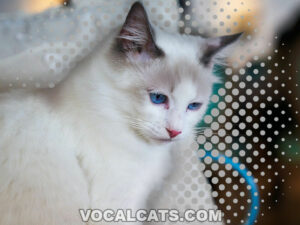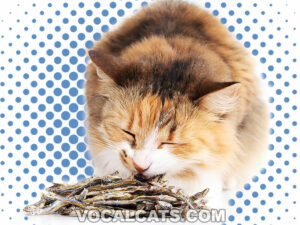Having a hard time choosing between two of the most affectionate cat breeds in town? In a gist, the main difference between a Himalayan Cat and a Ragdoll Cat is that Himalayan Cat is smaller, weighing an average of 7 to 12 pounds while Ragdoll Cat is bigger with an average weight of 15 to 20 pounds.
The Himalayan and the Ragdoll Cats are delightful pets to own. They both share a lot of similarities which include their love for human companionship.
Similar they may be but these two cats are different breeds. In this article, we will differentiate between a Himalayan Cat and a Ragdoll Cat. Which of the two cats is more clingy, harder to groom, and much more? So, let’s see how they differ from one another.
Contents
- Himalayan vs Ragdoll: Difference overview
- Which is better Himalayan or Ragdoll?
- Himalayan Cat Breed Overview
- Himalayan Cat Personality Traits
- Himalayan Cat Grooming Requirements
- Himalayan Cat Health Issues
- Himalayan Cat Breeder
- Living Conditions
- Himalayan Cat CFA Recognition
- Ragdoll Cat Breed Overview
- Ragdoll Cat Personality Traits
- Ragdoll Cat Grooming Requirements
- Ragdoll Cat Health Issues
- Ragdoll Cat Breeder
- Living Conditions
- Ragdoll Cat CFA Recognition
- Ragdoll vs Himalayan: Side-by-Side Comparison
- Himalayan vs Ragdoll: Physical Appearance
- Ragdoll vs Himalayan Cat Coat colors and types
- Himalayan Cat vs Ragdoll Personality
- Ragdoll Cat vs Himalayan Health Issues
- Himalayan Vs Ragdoll Cat lifespan
- Birman Vs Ragdoll Vs Himalayan
- Ragdoll Vs Himalayan Persian
- Which Cat Breed Is Right For You?
- Related Questions
Himalayan vs Ragdoll: Difference overview
| Breed Characteristics | Himalayan | Ragdoll |
| Adult Average Height | 10 – 12 inches | 9 – 11 inches |
| Adult Average Weight | 7 – 12 pounds | 15 – 20 pounds |
| Health Issues | Moderate | Moderate |
| Lifespan | 9 – 15 years | 12 – 16 years |
| Activity Level | Low | Low |
| Dietary Requirements | Moderate | Moderate |
| Grooming Needs | High | Moderate |
| Coal Length | Long | Medium – Long |
| Coat Color | Seal, Blue, Chocolate, Lilac, Red, Cream | Seal, Blue, Chocolate, Lilac, Red, Cream |
| Eye Color | Blue | Blue |
| Personality | Easygoing, Friendly, Affectionate, Amiable | Docile, Calm, Friendly, Sociable |
| Family-friendly | High | High |
| Pet-friendly | Moderate – High | High |
ALSO READ: Lilac Ragdoll (Complete Guide)
Which is better Himalayan or Ragdoll?
The Himalayan and the Ragdoll are both calm and affectionate cat breeds. The two cat breeds almost share similar characteristics in terms of temperament and attitude and can best be described as people-oriented.
The Himalayan, however, is the more independent of the two and would sometimes like to have its own quiet time.
The Ragdolls are happiest when being coddled and showered with attention. And while the Himalayan Cats can be a little bit clingy, they are not unduly needy.
RECOMMENDED: Himalayan Maine Coon Mix (Complete Guide)
Himalayan Cat Breed Overview
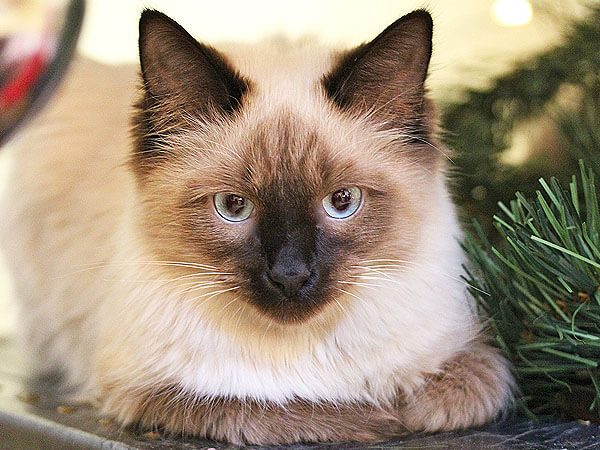
Himalayan Cat Personality Traits
The Himalayan or Himmie is a gentle and calm breed. They are not overly active and may seem lazy at times preferring to lounge and being content watching the goings-on around the house. But, this doesn’t mean they are not affectionate.
The Himalayan Cats enjoy being in the company of their family. They are often seen sitting next to or cozying up on the lap of their owner.
Although Himmies love being cuddled and petted, they are not very demanding of attention and can be left alone for short periods.
Himalayan Cats are also playful without being overly rambunctious. They do not have high exercise needs and have short spurts of energy between their naps throughout the day.
Plus, Himalayan Cats are also said to be attuned to their owner’s emotions and moods and would often express themselves by meowing in a melodious voice.
DON’T MISS: Siamese Himalayan Cat (Complete Guide)
Himalayan Cat Grooming Requirements
The Himalayan Cats are double-coated, hence, it requires more work to keep those thick and fluffy coats in excellent shape. This means daily grooming to prevent mats from forming.
You need at least a couple of brushes. One is a de-shedding tool to control shedding and the second one is a wide-tooth comb to address the problem of matting.
Occasional bathing is necessary to wash off debris from the coat. Next is dental care which can be done using an enzymatic toothpaste to clean gums and teeth.
Himalayan Cat Health Issues
Keeping your Himalayan cat in tip-top shape involves more than just regular meals and plenty of cuddles. Embracing the use of health detection tests can make a significant difference in monitoring your feline friend’s well-being.
These indispensable tools offer early insight into any deviations in their health, ensuring your Himalayan can enjoy a high quality of life, all while letting you rest easy knowing you’re providing the best possible care.
Briefly explained below are the seven (7) health issues that could affect a Himalayan Cat.
1. Polycystic Kidney Disorder (PKD)
This disease is characterized by tiny cysts that enlarge and multiply as the cat gets older.
2. Breathing Problems
Being a brachycephalic breed, a Himalayan Cat is very susceptible to difficulty in breathing. This is due to their shorter bones in the face and an elongated soft palate.
3. Feline Asthma
This disease is triggered by environmental factors like cigarette smoke and household cleaning products.
4. Dental Malocclusions
A dental disease characterized by a misalignment of the upper and lower jaw. This leads to chewing problems and tartar and plaque buildup.
5. Cherry Eye
An inflammation of the 3rd eyelid leads to the swelling and drying of the eyes.
6. Feline Hyperesthesia Syndrome
According to Cornell Feline Health Center, Feline Hyperesthesia Syndrome is a rolling skin disease that affects the various systems including the endocrine and the nervous systems.
The disease is manifested differently depending on which system is affected, some of which are aggression and excessive itchiness.
7. Hypertrophic Cardiomyopathy (HCM)
Cardiac heart disease is caused by the enlargement of the heart muscle.
Himalayan Cat Breeder
There are many positive aspects of buying a Himalayan Cat from a responsible breeder. First, responsible breeders do not skip the important aspect of breeding which is genetic screening.
DNA home test kits allow breeders to identify whether their breeding cats are carriers of gene-related diseases such as PKD. Those who tested positive are pulled out from their breeding programs.
Second, responsible breeders will allow the kittens to be with their mom and siblings up to 12 weeks of age.
Third, responsible breeders avoid breeding their cats more than 2x a year. This is to give the queen or female cat enough time to recover.
A female Himalayan Cat (queen) produces an average of 4 kittens in each litter. So, are you interested to buy a kitten? Here are 2 responsible breeders of Himalayan Cats:
- Karista Kats (karistakats.com/himalayan-kittens.htm) in New Jersey is a multi-awarded cattery of excellence by CFA.
- Gil-V-Tales (gil-vtales.com) in North Carolina is a TICA and CFA-registered cattery that sells kittens that are free from genetic diseases.
Living Conditions
Himalayan Cats, being a brachycephalic cat breed, are well-suited to live in colder countries. Otherwise, it’s best to provide a cooling system to prevent this breed from panting excessively.
The Himalayan Cats are not recommended to stay outdoors. It’s because subjecting them to heat or cold can cause respiratory problems.
So, keep your Himmies indoors because these guys love to play with children and with other housepets.
Unlike other breeds, the Himalayan Cats are not very fond of climbing on high perches. Rather, they enjoy cuddling and interacting with people of all ages.
Himalayan Cat CFA Recognition
The Himalayan is considered a sub-division of the Persian cat breed by the Cat Fanciers’ Association (CFA). It is often referred to as the Colorpoint Persian Cat.
An application for the Himalayan as a separate breed was submitted in 1957. But over the years, the criteria for a breed standard was not met, which called for a Persian-type short nose with a Siamese-like colorpoint longhair coat.
Some Himalayan cats produce longer noses that don’t adhere to the standard. It’s because some breeders did not use Persian cats in their breeding program.
In succeeding years, an effort was started to breed Himalayans by using Persian cats more to return to the standard they were aiming for. But, these resulted in Himalayans resembling the Persians even more and therefore recognized only as a variant.
Ragdoll Cat Breed Overview
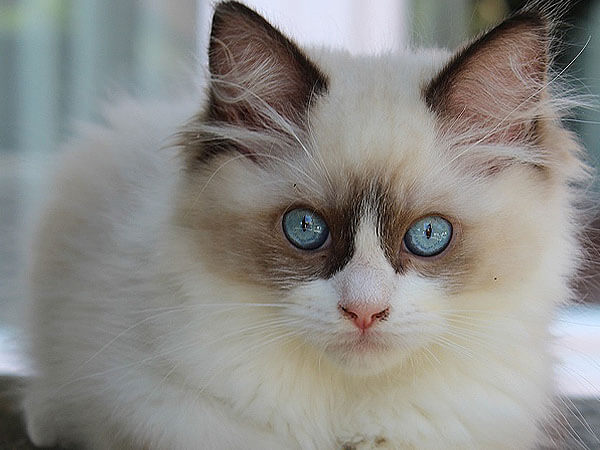
Ragdoll Cat Personality Traits
The Ragdoll got its name because they tended to go limp when being held. They are very docile and calm. They demonstrate no amount of aggression whatsoever to people and other pets, leading some to mistakenly believe that they might be impervious to pain.
They are known to be dog-like in their behavior that likes to follow their owners around. Ragdoll Cats exhibit great friendliness and sociability with almost anyone.
Ragdolls are known to remain playful into their later years due to their slow maturation process which can take up to 4 years.
They also prefer staying low on the ground unlike other cat breeds that like to perch on higher grounds to have a better vantage point for predators.
READ ALSO: Persian Ragdoll Cat (Complete Guide)
Ragdoll Cat Grooming Requirements
Ragdolls are known for their thick coat but did you know that they only have one layer of long and plush coat? Unlike the Himalayan Cats, the Ragdolls require less brushing which can be done at least 3x a week.
Aside from brushing the coat with a de-shedding tool and a wide-tooth comb to remove tangles, it’s also recommended to use a soft-bristled brush to distribute the natural oil. This will make the skin softer and the coat smoother.
You may be interested in: Do Ragdoll Cats Shed? 7 Ways To Shed Less!
Ragdoll Cat Health Issues
Ragdolls are generally healthy but they can also be vulnerable to the following diseases:
1. Progressive Retinal Atrophy (PRA)
A progressive eye disease affecting the photoreceptors. This leads to blindness later in life.
2. Hypertrophic Cardiomyopathy (HCM)
Ragdolls that carry the 2 copies of mutated genes known as HCMrd are vulnerable to HCM. Studies have shown that about 30% of the Ragdoll population carries this mutated gene.
3. Feline Aortic Thromboembolism (FATE)
A heart disease that causes blood clotting in the arteries leading to paralysis.
4. Neonatal Isoerythrolysis (NI)
Commonly seen among Ragdolls with type B blood, this is caused by an incompatibility in the blood type of the mother and kitten.
5. Obesity
Ragdolls are not fond of physical activities. This makes them prone to weight gain.
Ragdoll Cat Breeder
Listed below are some criteria on what to look for in a Ragdoll breeder:
- The breeder should perform DNA tests on the breeding parents to rule out genetic diseases like HCM and PRA.
- For socialization purposes, the breeder should not separate the kittens from their mothers before 12 weeks of age.
- Ideally, the breeder should only allow Ragdolls to produce litter twice a year so as not to strain their bodies.
Typically, a Ragdoll Cat produces 3 to 6 kittens in a litter. Looking for a healthy Ragdoll kitten? Here are two (2) breeders to go to:
If you’re in Michigan, visit the Facebook page of Cashmere Ragdolls for lovely kittens for sale.
For anyone living in New York, check out Osoragdolls (osoragdolls.com).
Both of these catteries are TICA-registered.
Living Conditions
While Ragdolls are built to thrive in cold climates, it doesn’t mean they cannot adapt to warm and humid climates. For as long as they have access to cooler areas in the home and are provided with water, Ragdoll Cats can adjust to higher temperatures.
READ NEXT: Do Ragdoll Cats Like Water?
Can Ragdolls go outdoors? They are best kept indoors because they are so gentle to the point that they aren’t smart enough to protect themselves from harm like aggressive cats.
Besides, Ragdolls are very playful and they aren’t bothered if the playing gets rough with kids and other housepets.
Ragdoll Cat CFA Recognition
The Ragdoll was recognized as an official breed by the Cat Fanciers’ Association in 1998. Among the 45 pedigreed breeds in CFA’s roster, the Ragdoll was ranked number No. 1 for four straight years starting in 2019.
Its history in becoming recognized by the CFA started in 1975. This is when the couple, Denny and Laura Dayton, broke ranks with Ann Baker, who developed the Ragdoll. Baker initially formed her registry, the International Ragdoll Cat Association (IRCA), and forbid the Ragdoll to be registered in other cat registries.
The husband-and-wife team then developed the Ragdoll standard over the years which eventually was accepted by the CFA.
Ragdoll vs Himalayan: Side-by-Side Comparison
Himalayan vs Ragdoll: Physical Appearance
Himalayan Cats are medium-sized felines with short, somewhat rounded bodies compared to the Ragdoll which is large and long-bodied with a more rectangular shape.
Himalayans also have long, straight top coats with a dense undercoat which makes them appear larger. The Ragdoll, on the other hand, has an abundant silky, semi-long guard coat with minimal undercoat which requires less grooming.
The face shape of both breeds also differs in some ways. The Himalayans have flatter noses similar to the Persian cat that has a rounded skull structure with the nose, forehead, and chin in vertical alignment. The Ragdoll, on the other hand, has an equilateral, triangular head shape with a softly rounded nose.
The two physical features that both breeds do share in common are having a color pointed coat and striking, blue eyes.
You may also like: Blue Eyed White Ragdoll (Complete Guide)
Ragdoll vs Himalayan Cat Coat colors and types
The Ragdoll and the Himalayan both present with colorpointed coats with the extremities, such as the head, ears, legs, and tail being strikingly darker in color than their body coat.
What sets the Ragdoll apart from the Himalayan is that Ragdolls can have modified colorpoint patterns aside from the standard, such as mitted, bicolor, or van.
Ragdolls can have white on their face masks like the inverted ‘V’ white pattern in bicolors, and white paws which are found in Mitted Ragdolls. The Van pattern in Ragdolls exhibits point coloring only on the ears, tail, and sometimes mask with the legs being completely white.
The Himalayan Cat only sports the standard colorpoint pattern with no white patterns on the face mask or paws.
Himalayan Cat vs Ragdoll Personality
The Ragdoll and the Himalayan almost have similar personalities. Both are described as puppy-like in attitude because of their gentle and friendly personalities.
They love the attention and company of their family a lot with the tendency to follow their favorite person around. Both also enjoy being cuddled and handled, showing no aggressive behavior whatsoever.
The Ragdoll though is more playful than the Himalayan and may demand more attention from their owners.
The Himalayan has a more laid-back and relaxed attitude preferring sometimes to stay quiet.
But, Himalayan Cats can be vocal and can make melodious meows, chirps, and trills when they want attention.
CHECK OUT: Are Ragdoll Cats Talkative Or Vocal?
Ragdoll Cat vs Himalayan Health Issues
Between the Himalayan Cat and the Ragdoll Cat, it is the Himalayan Cat that is more prone to health problems. This is because cats belonging to the brachycephalic group have shorter skulls which give the Himalayan Cats a flat-face appearance.
And, because of the shorter skull, some of their facial tissues are altered. This leads to a host of health problems for the Himalayan cats which include breathing, dental, and eye problems.
Plus, it can also lead to digestive and temperature control problems.
Himalayan Vs Ragdoll Cat lifespan
Due to the flat-faced muzzle for brachycephalic face of the Himalayan, they are more susceptible to certain respiratory and eye problems compared to the Ragdoll.
This makes Ragdolls much healthier and therefore potentially have longer lifespans. Himalayan cats have a higher incidence of having breathing difficulty and also dental malocclusions with the top and lower jaw not fitting neatly.
Birman Vs Ragdoll Vs Himalayan
The Himalayan and Birman cats only present with a standard colorpoint pattern with no white markings on the face, whereas the Ragdoll can have several colorpoint markings such as mitted, van, or bicolor.
The Birman cat though always has white paws which is similar to the Mitted Ragdoll, while Himalayan cats would always exhibit colored paws.
The difference between a Mitted Ragdoll and a Birman is that the mittens on the back legs of a Birman cannot extend beyond the hock and the colorpoint gloves have an inverted ‘V’ pattern.
On the one hand, with the mitted Ragdoll, the mittens can extend beyond the hock and the colorpoint is even. Mitted Ragdolls also sport a white chin while a Birman does not.
Ragdoll Vs Himalayan Persian
What sets the Persian Cat apart from the Ragdoll and the Himalayan is that their coat can come in various colors and patterns. Persian cats can be solid-colored to tabby and tortoiseshell and from shaded to cameo. The Ragdoll and Himalayan only come in a colorpoint coat pattern.
In terms of body shape and facial features, the Himalayan and the Persians almost have a similar appearance, with the Himalayan considered a sub-group of the Persian breed by the CFA.
Which Cat Breed Is Right For You?
While both of these cats have wonderful personalities, it is the Ragdoll Cat that has a ‘velcro-like’ personality. So, if you’d rather get an affectionate cat yet not too clingy, then a Himalayan is the perfect choice.
But, if you’d rather get a cat that won’t demand too much of your time grooming, then you should get a Ragdoll that sheds less than a Himalayan Cat.
Regardless of your choice, be sure to get your cat from a responsible breeder and be prepared for the financial responsibilities that go with cat ownership.
Related Questions
Himalayan Ragdolls are medium to large cats that can reach a height of 12 to 16 inches and weigh between 8 to 15 pounds.
The Ragdoll was developed from crossing a non-pedigreed domestic longhaired white female cat with a Burmese or Birman-type cat.
DISCLAIMER: THIS WEBSITE DOES NOT PROVIDE MEDICAL ADVICE
The information, including but not limited to, text, graphics, images and other material contained on this website are for informational purposes only. No material on this site is intended to be a substitute for professional veterinary advice, diagnosis, or treatment. Always seek the advice of your veterinarian or other qualified health care provider with any questions you may have regarding a medical condition.
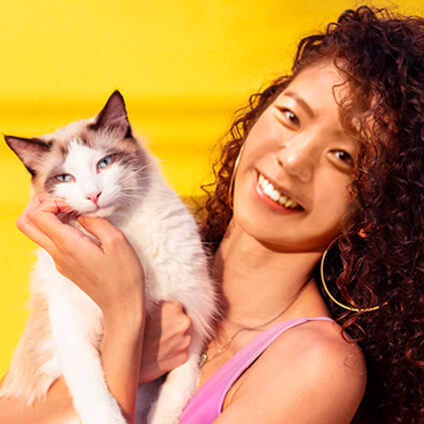
With over five years of specialized experience as an animal writer, my expertise lies in cat nutrition, health, behavior, grooming, and training. I am dedicated to delivering helpful and informative content that caters to the well-being of our feline friends. My primary goal is to empower pet owners with knowledge and ensure our feline companions thrive in health and happiness. In my free time, I love volunteering at local cat rescue centers.
